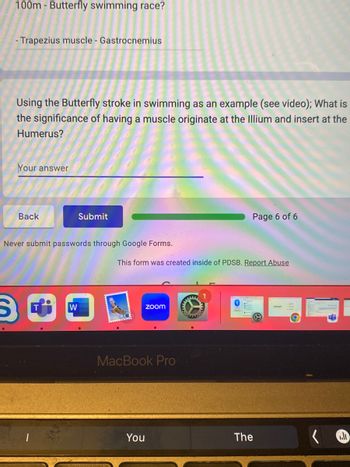
Human Anatomy & Physiology (11th Edition)
11th Edition
ISBN: 9780134580999
Author: Elaine N. Marieb, Katja N. Hoehn
Publisher: PEARSON
expand_more
expand_more
format_list_bulleted
Concept explainers
Question

Transcribed Image Text:100m - Butterfly swimming race?
- Trapezius muscle - Gastrocnemius
Using the Butterfly stroke in swimming as an example (see video); What is
the significance of having a muscle originate at the Illium and insert at the
Humerus?
Your answer
Back
Submit
Never submit passwords through Google Forms.
W
This form was created inside of PDSB. Report Abuse
zoom
MacBook Pro
You
Page 6 of 6
The
Expert Solution
This question has been solved!
Explore an expertly crafted, step-by-step solution for a thorough understanding of key concepts.
Step by stepSolved in 2 steps

Knowledge Booster
Learn more about
Need a deep-dive on the concept behind this application? Look no further. Learn more about this topic, biology and related others by exploring similar questions and additional content below.Similar questions
- For a given movement, differentiate specific muscles that function as prime mover, antagonist, synergist or fixator.arrow_forwardDiscuss the types of muscles as to their specific actions. Give the homologiesarrow_forwardThis muscle is the major “antagonist” of the muscles that flex the forearm. (What is an “antagonist?”)This muscle affects the scapula, and would be involved with “shrugging” the shoulders (shrugging the shoulders is lifting them up in an “I don’t know…” posture).This muscle could bring the arm downward in a power stroke, as if to strike a blow.arrow_forward
- Most of the muscles of the skeleton are attached to areas very close to the joints, so their arms, although they are very small, their mechanisms allow the movement of the human body. (a) How are they considered from the point of view of force efficiency? (b) What are the biomechanical benefits?arrow_forwardWith the paired muscles along the spine, a more origin (attachment) will allow the muscle to generate more rotation and/or lateral flexion when only one side of the paired muscle is activate.arrow_forwardIdentify a muscle that everts the foot and two muscles of either the hand or foot that are considered to be intrinsic muscles of that structure. Be sure to state clearly which muscle everts and which muscles are intrinsic.arrow_forward
- Name one muscle that has its origin from the process pointed with the arrow.arrow_forwardName the types of muscles and mention to characteristics of each.arrow_forwardLocate and list two different pairs of muscles that act as on the body as agonist/antagonist. (That is, in each pair, one muscle will produce a movement, such as flexion, that the other muscle will undo, and produce extension; abduction/adduction, etc. are other ways that muscle produce opposite actions on the same part of the body).Name two muscles that act as “fixators.” (What are fixators?) What joint or joints are they helping to stabilize?Why is the biceps brachii called a “bicep,” while the triceps brachii is called a “triceps?”What is the difference between a muscle with “longus” as part of its name and a muscle with “brevis” as a part of its name?arrow_forward
- Discuss the different ways of naming muscles, and give two examples eacharrow_forwardSelect the two most appropriate muscle(s) that perform(s) this body movement: Temporalis Zygomaticus Masseter Sternohyoid Occipitalis Buccinatorarrow_forwardDiscuss the functions of the different types of levers found in our body. How do these different types of levers make our body more useful. Explain each type of lever, the position of the fulcrum, load, and applied force and give an example of each.arrow_forward
arrow_back_ios
SEE MORE QUESTIONS
arrow_forward_ios
Recommended textbooks for you
 Human Anatomy & Physiology (11th Edition)BiologyISBN:9780134580999Author:Elaine N. Marieb, Katja N. HoehnPublisher:PEARSON
Human Anatomy & Physiology (11th Edition)BiologyISBN:9780134580999Author:Elaine N. Marieb, Katja N. HoehnPublisher:PEARSON Biology 2eBiologyISBN:9781947172517Author:Matthew Douglas, Jung Choi, Mary Ann ClarkPublisher:OpenStax
Biology 2eBiologyISBN:9781947172517Author:Matthew Douglas, Jung Choi, Mary Ann ClarkPublisher:OpenStax Anatomy & PhysiologyBiologyISBN:9781259398629Author:McKinley, Michael P., O'loughlin, Valerie Dean, Bidle, Theresa StouterPublisher:Mcgraw Hill Education,
Anatomy & PhysiologyBiologyISBN:9781259398629Author:McKinley, Michael P., O'loughlin, Valerie Dean, Bidle, Theresa StouterPublisher:Mcgraw Hill Education, Molecular Biology of the Cell (Sixth Edition)BiologyISBN:9780815344322Author:Bruce Alberts, Alexander D. Johnson, Julian Lewis, David Morgan, Martin Raff, Keith Roberts, Peter WalterPublisher:W. W. Norton & Company
Molecular Biology of the Cell (Sixth Edition)BiologyISBN:9780815344322Author:Bruce Alberts, Alexander D. Johnson, Julian Lewis, David Morgan, Martin Raff, Keith Roberts, Peter WalterPublisher:W. W. Norton & Company Laboratory Manual For Human Anatomy & PhysiologyBiologyISBN:9781260159363Author:Martin, Terry R., Prentice-craver, CynthiaPublisher:McGraw-Hill Publishing Co.
Laboratory Manual For Human Anatomy & PhysiologyBiologyISBN:9781260159363Author:Martin, Terry R., Prentice-craver, CynthiaPublisher:McGraw-Hill Publishing Co. Inquiry Into Life (16th Edition)BiologyISBN:9781260231700Author:Sylvia S. Mader, Michael WindelspechtPublisher:McGraw Hill Education
Inquiry Into Life (16th Edition)BiologyISBN:9781260231700Author:Sylvia S. Mader, Michael WindelspechtPublisher:McGraw Hill Education

Human Anatomy & Physiology (11th Edition)
Biology
ISBN:9780134580999
Author:Elaine N. Marieb, Katja N. Hoehn
Publisher:PEARSON

Biology 2e
Biology
ISBN:9781947172517
Author:Matthew Douglas, Jung Choi, Mary Ann Clark
Publisher:OpenStax

Anatomy & Physiology
Biology
ISBN:9781259398629
Author:McKinley, Michael P., O'loughlin, Valerie Dean, Bidle, Theresa Stouter
Publisher:Mcgraw Hill Education,

Molecular Biology of the Cell (Sixth Edition)
Biology
ISBN:9780815344322
Author:Bruce Alberts, Alexander D. Johnson, Julian Lewis, David Morgan, Martin Raff, Keith Roberts, Peter Walter
Publisher:W. W. Norton & Company

Laboratory Manual For Human Anatomy & Physiology
Biology
ISBN:9781260159363
Author:Martin, Terry R., Prentice-craver, Cynthia
Publisher:McGraw-Hill Publishing Co.

Inquiry Into Life (16th Edition)
Biology
ISBN:9781260231700
Author:Sylvia S. Mader, Michael Windelspecht
Publisher:McGraw Hill Education